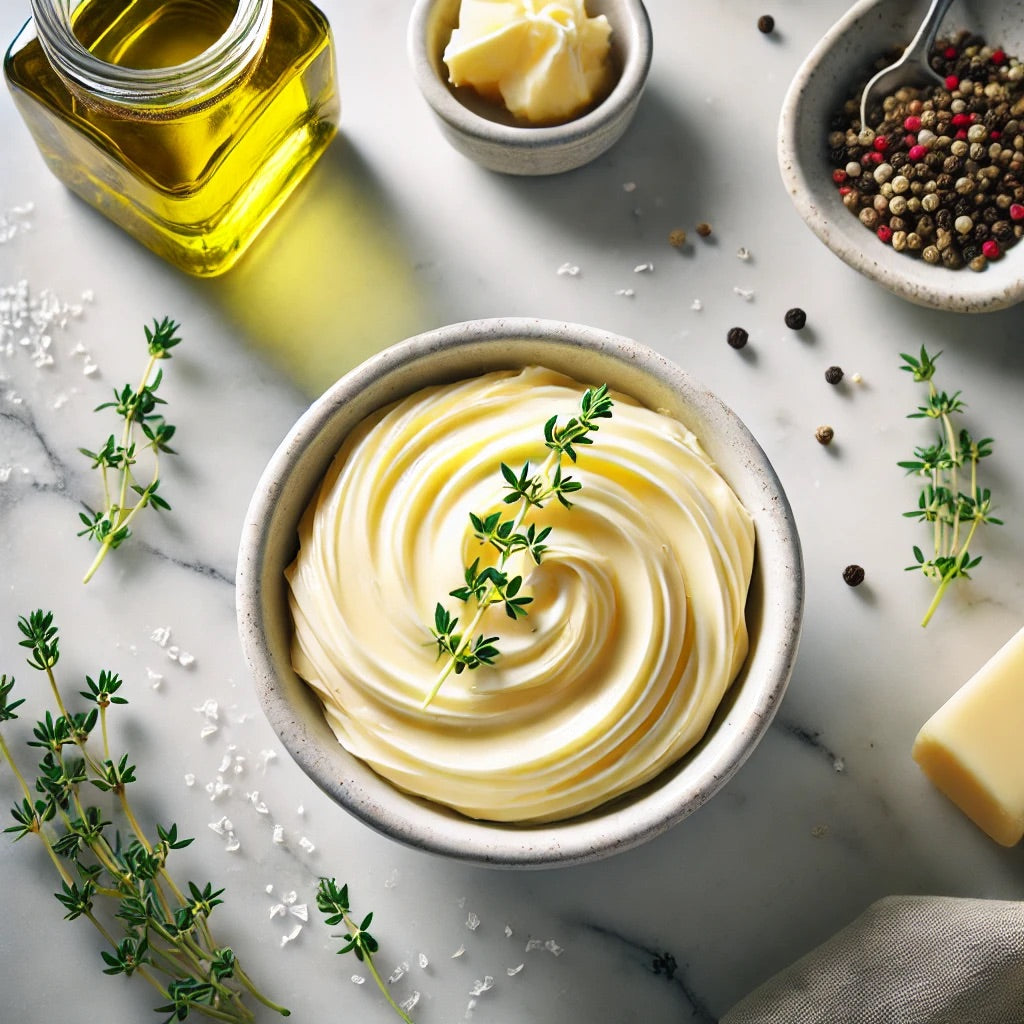
Butter in Cooking: Understanding Its Role and Vegan Alternatives with a DIY Recipe
Share
Butter has long been a staple ingredient in many kitchens, known for its rich flavor, creamy texture, and versatility. Whether used in baking, sautéing, or as a finishing touch to dishes, butter imparts a unique flavor profile that enhances the taste and mouthfeel of various recipes. However, as the trend towards plant-based diets and veganism continues to grow, many home cooks and bakers are looking for viable dairy-free alternatives. This article will explore the role of butter in cooking, provide guidance on how to choose vegan options, and include a step-by-step recipe for making homemade vegan butter.

What Makes Butter Essential in Cooking?
Butter serves multiple purposes in the culinary world, adding flavor, moisture, and a delicate balance of fat that helps bind ingredients together. In baking, it plays a critical role in creating flakiness in pastries, richness in cakes, and moisture in cookies. When used for frying or sautéing, butter has a lower smoke point than many oils, allowing for gentle cooking that imparts a subtle, nutty flavor.
Why Choose Vegan Butter?
With increased awareness around dairy allergies, ethical concerns, and a desire to reduce animal-based products, vegan butter offers a suitable alternative. Unlike traditional butter made from cow’s milk, vegan butter is crafted from plant-based oils like coconut, olive, or avocado oil, providing a similar creamy texture without the cholesterol.
What to Look For in Vegan Butter Substitutes
When choosing a vegan butter alternative, it’s important to read ingredient labels carefully. Here are some key factors to consider:
1. Check the Ingredients List:
- Opt for products with minimal ingredients, free from artificial additives or preservatives.
- Look for natural stabilizers like tapioca starch or lecithin instead of hydrogenated oils, which can be harmful.
2. Focus on the Oil Base:
- Choose options made from high-quality oils such as olive oil, avocado oil, or coconut oil.
- Refined coconut oil is often preferred for its neutral flavor, while unrefined coconut oil can impart a strong coconut taste.
3. Avoid Palm Oil:
- Many commercial vegan butters contain palm oil, which is linked to deforestation and environmental harm.
- Look for products labeled “palm oil-free” or consider making your own vegan butter at home to avoid this ingredient entirely.
4. Consider Texture and Taste:
- Depending on your intended use (spreading, baking, or cooking), the texture and consistency of vegan butter can vary.
- Taste is subjective, so try a few brands to find one that best suits your needs.
Ingredients to Avoid in Vegan Butter Substitutes
Despite being labeled vegan, some plant-based butters may still contain ingredients you want to avoid:
- Hydrogenated Oils or Trans Fats: These can contribute to health issues such as heart disease.
- Artificial Flavorings: Opt for products that use natural flavorings or no added flavorings at all.
- Excessive Salt or Sugar: Look for low-sodium options to keep your intake balanced.

Homemade Vegan Butter Recipe: A Healthier and Tastier Alternative
Making your own vegan butter at home can be a rewarding and health-conscious choice. You have complete control over the ingredients, allowing you to customize the flavor, texture, and health benefits to your liking. Here’s a simple recipe to get started:
DIY Vegan Butter Recipe
Ingredients:
- 1 cup refined coconut oil (melted and slightly cooled)
- 1/4 cup avocado oil
- 1/4 cup canned full-fat coconut milk (room temperature)
- 1 tablespoon tapioca starch (for creaminess and thickness)
- 1 tablespoon apple cider vinegar
- 1/2 teaspoon salt (adjust to taste)
- 1/4 teaspoon turmeric powder (optional, for a buttery yellow color)
- 1/4 teaspoon nutritional yeast (optional, for a deeper umami flavor)
Instructions:
-
Melt the Coconut Oil:
Place the refined coconut oil in a small bowl and gently melt it using a double boiler or microwave. Allow it to cool slightly so it’s warm but not hot. -
Create the Tapioca Mixture:
In a separate small saucepan, whisk the tapioca starch into the coconut milk until fully dissolved. Gently heat the mixture over low heat, stirring constantly, until it thickens slightly (about 2-3 minutes). It should become a smooth, glossy mixture. Remove from heat and let cool for a minute. -
Blend the Ingredients:
In a high-speed blender or food processor, combine the melted coconut oil, avocado oil, tapioca-coconut mixture, apple cider vinegar, salt, turmeric, and nutritional yeast (if using). Blend for 1-2 minutes until the mixture is fully emulsified and smooth. -
Chill to Set:
Transfer the mixture to a glass container or silicone mold. Place in the refrigerator for 2-3 hours, or until completely firm. -
Serve & Store:
Once set, your homemade vegan butter is ready to use! Store in the refrigerator for up to 2 weeks, or freeze in portions for up to 3 months.

Tips for Customizing Your Vegan Butter:
- For a Tangy Flavor: Add a pinch more apple cider vinegar or a dash of lemon juice.
- For a Firmer Consistency: Increase the amount of coconut oil slightly.
- For a Spreadable Texture: Substitute part of the avocado oil with sunflower oil.
No Churn Vegan Butter
Butter’s unique role in cooking makes it a cherished ingredient, but with the growing demand for plant-based alternatives, there are numerous vegan options to explore. By understanding what to look for in store-bought varieties and mastering a homemade recipe, you can enjoy the rich, creamy goodness of butter without compromising on health or ethics.
_______________________________
FAQs About Vegan Butter
-
Can I bake with homemade vegan butter?
- Yes! Homemade vegan butter works well in most baking recipes. Just ensure it’s chilled and firm before using.
-
Is store-bought vegan butter healthier than regular butter?
- It depends on the brand and ingredients. Choose options made from healthy oils and free from trans fats.
-
Why does my homemade vegan butter separate?
- This can happen if the ingredients weren’t fully emulsified. Blend for a bit longer until smooth and creamy.
-
Can I use unrefined coconut oil?
- Unrefined coconut oil will impart a coconut flavor. Use refined coconut oil for a more neutral taste.
-
What is the best oil to use in vegan butter?
- Avocado oil is ideal for its light flavor, while olive oil offers a richer taste. Choose based on your preference!

1 comment
This vegan butter recipe looks creamy and delicious. It is dairy-free and can be made at home easily, so I really appreciate that.